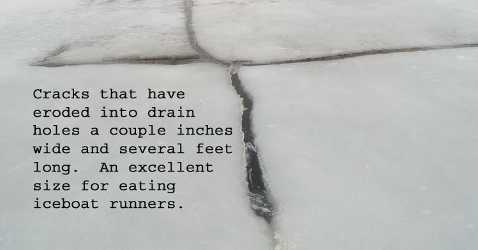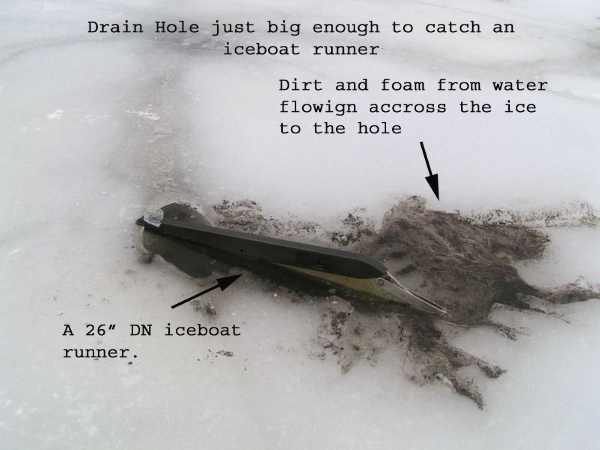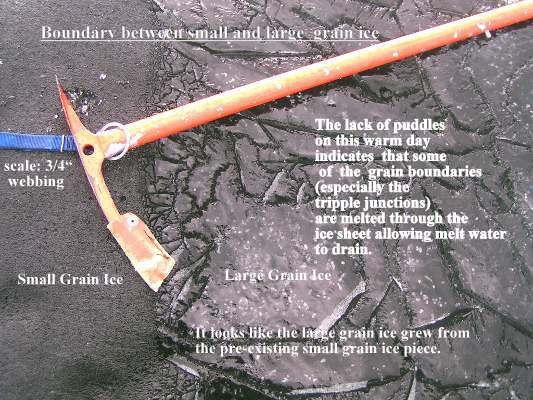
Water can accumulate on an ice sheet in heavy rain but also during a period of warm wind which, in a day, can easily turn a couple inches of the top of the ice sheet into water. Wind can also blow large amounts of water onto an ice sheet from any open water. Since the ice is less dense than the water it will flow through the ice sheet at any available hole. This generally plays out in one or both of the following ways:
Scenario 1) The water finds open cracks and fishing holes to drain through. The flow of moderately warm water enlarges these holes. They can get several feet long and a foot wide. Big holes are more likely in cloudy weather, earlier in the season.
 Aprox 2 by 3 foot, partially refrozen drain hole with an octopus to the right (a refrozen upflow hole). Photo by Jeff Brown
Aprox 2 by 3 foot, partially refrozen drain hole with an octopus to the right (a refrozen upflow hole). Photo by Jeff Brown
Typically water accumulates on the ice while the holes are too small to drain the water as fast as it is accumulating. Pressure in the warming ice causes some areas to flex down a little. The water flows there and helps the compression force push the ice deeper. Puddles can get several inches deep. The puddled water flows through any cracks or holes it can find. These get eroded out to a significantly larger size, especially cracks. Once all the water has drained the ice rebounds and the ice is, for the most part, dry. On 8 inch black ice the time frame for this is roughly a day of rain and melt water forming and pooling. The next day the ice may have a dry surface with small to big drain holes here and there. This is a good time to be extra careful on skates or on foot and to leave the iceboat parked.

Scenario 2) The entire thickness of the ice sheet warms up enough to melt the triple junctions between the ice grains. This creates a large number of very small holes. These let the water through in so many places that none of them get very large. Typically the bigger of these holes erodes to only an inch or two in diameter. This is more common in thicker ice and later in the season. Internal heating by the sun to create the melted triple junctions may be an important factor (more).
 Well thawed ice at the boundary between small and large grain areas. Many of the junctions between the ice grains have melted all the way through the ice sheet forming lots of tiny drain holes. Any water on the surface quickly percolates through the ice.
Well thawed ice at the boundary between small and large grain areas. Many of the junctions between the ice grains have melted all the way through the ice sheet forming lots of tiny drain holes. Any water on the surface quickly percolates through the ice.
Drain holes typically refreeze quickly after the weather cools as they do not have an ongoing melting process like a gas hole does. Dry shell ice may be widespread after the water drains off and the weather cools.
Drain holes should be expected after any significant thaw. If you find one there will almost always be lots more if you look hard enough. The most hazardous ones typically form in cracks. If you are on ice that is still wet they can be difficult to spot holes among the puddles. They often have an accumulation of dirty foam right at the hole and sometimes there is enough flow to form a visible 'dimple' on the water surface. Their most insidious time is when they have skinned but are still thin.
